Tulamben Dive Sites Guide:
Wreck, Reef & Macro Heaven
TULAMBEN – Diving Spots, Dive Sites Map & POI
TULAMBEN – Diving Spots, Dive Sites Map & POI
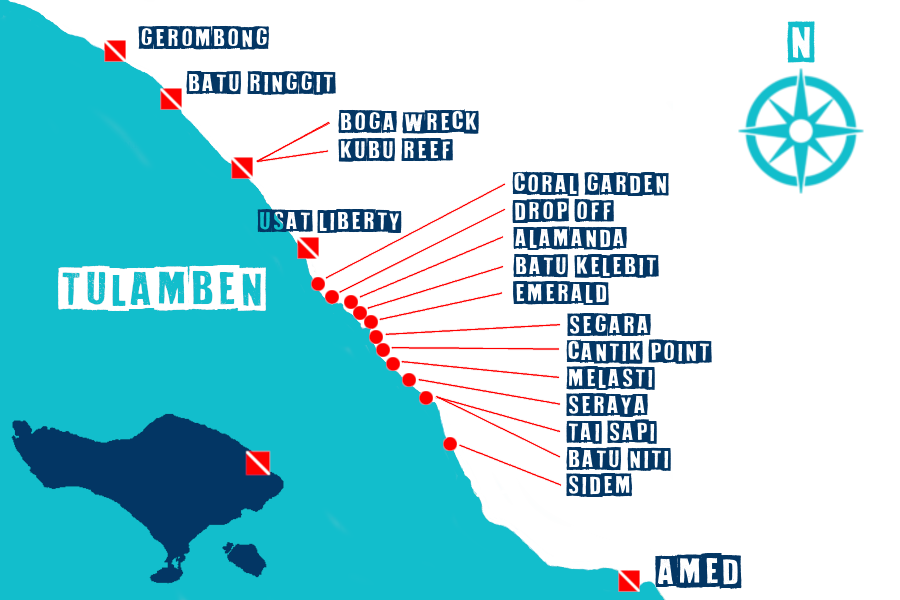
Tulamben is one of Bali’s most iconic scuba diving areas, with dive sites spread along 10 kilometers of coastline — starting from Gerombong in the north, passing the famous USAT Liberty Shipwreck in the heart of the village, and continuing down to the slopes of Sidem in the south. Known for its easy access, rich marine life, and year-round diving conditions, Tulamben offers a wide variety of shore and some local boat dives, perfect for both beginners and experienced divers. Whether you’re visiting for a daily dive trip or a full diving holiday, Tulamben has something for everyone.
The USAT Liberty Shipwreck, Coral Garden, and Drop Off are the area’s most visited sites — ideal for fun dives, dive training, snorkeling, and photography, thanks to their easy access and abundant marine life. These signature sites make Tulamben a top choice for Bali Aqua’s daily dive trips from South Bali and diving packages.
For wreck diving enthusiasts, Tulamben is home to not one but two sunken treasures:
If you’re passionate about macro life and underwater photography, Tulamben is one of the best places in Bali for Macro and Muck lovers. Many dive sites along the coast — from the black sand slopes of the main village to nearby sites in both directions — are home to a wide range of fascinating critters. Depending on the season and conditions, you can spot nudibranchs, ghost pipefish, frogfish, rare shrimps, and many other rare species, making Tulamben a true paradise for critter hunters and camera lovers alike.
This guide covers more than 17 dive sites in the Tulamben region, making it the most complete online reference for divers planning to explore the best this coast has to offer.
Macro Diving & Seasonality in Tulamben
Some of the best macro dive sites in Tulamben shift in quality depending on the time of year and local conditions. Some sites may be buzzing with rare critters for a couple of months and then become quite poor for a couple of months again. That’s why it’s essential to dive with experienced local guides who know where to go and when.
At Bali Aqua, our team of passionate and macro dive guides constantly monitor seasonal critter trends and site conditions. We tailor each dive to match what’s hot at the moment — Our expertise ensures that you’re diving the right site at the right moment for the best photo opportunities and marine life encounters.
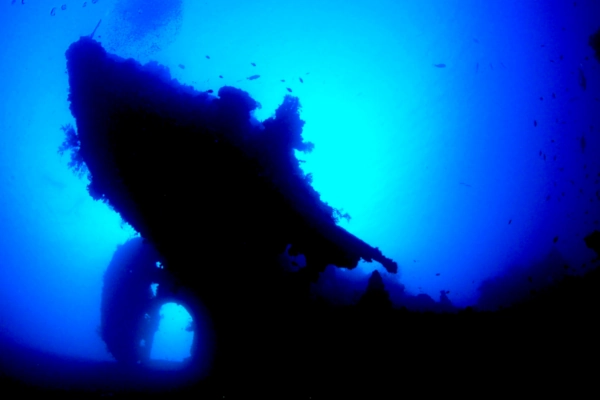
The USAT Liberty is the most famous dive site in Tulamben — and one of the top wreck dives in the world. This 125-meter-long American cargo ship was torpedoed by a Japanese submarine during World War II in 1942 while carrying supplies from Australia. Badly damaged, the ship was towed toward North Bali, but it was taking on too much water. The crew made the decision to beach it at Tulamben, where it remained for over 20 years. In 1963, the eruption of Mount Agung triggered earthquakes that caused the wreck to slide off the beach and sink just a few meters into the sea. Today, the wreck lies parallel to the shore, resting between 5 and 30 meters deep, making it one of the most accessible shipwrecks for all levels of divers — from beginners to experienced underwater photographers.
Over the decades, the Liberty has become an artificial reef, fully covered with hard and soft corals, giant sponges, sea fans, and home to a wide variety of marine life. During your dive, you may see schools of trevallies, bumphead parrotfish, groupers, moray eels, barracudas, and countless smaller reef fish. The shallow parts are perfect for long, relaxed dives, and the deeper sections are ideal for exploration. At night, the wreck transforms into a different world, with oportunist grouper, hunting moray and lionfish, and the chance to spot Spanish dancers and other nocturnal critters.
Accessible directly from the beach, the USAT Liberty is ideal for fun dives, underwater photography, training dives, and night dives. It’s a must-see for every diver visiting Bali.

Just a short swim from the USAT Liberty Wreck, Coral Garden is one of Tulamben’s most enjoyable dive sites — perfect for a relaxed reef dive, underwater photography, or even a memorable night dive. Depth ranges between 3 and 20 meters, with most of the marine life concentrated in the shallower areas, making it ideal for all levels of divers. For those with more experience, going deeper can reveal less-visited zones with larger sponges and rare macro species.
True to its name, Coral Garden features a colorful mix of hard and soft corals, along with large colonies of anemones and a wide variety of reef fish. But what makes this site unique is the presence of Balinese-style artificial structures placed on the sandy bottom. The first part includes a stupa-shaped sculpture, inspired by the Borobudur temple in Java, followed by statues and temple-like formations that have been colonized by marine life over time.
These manmade features have become popular cleaning stations, especially in deeper areas, attracting wrasses, shrimp, and crabs, and occasionally even leaf scorpionfish or ghost pipefish. Night dives here are especially productive, with excellent opportunities to spot crustaceans, hunting cuttlefish, decorator crabs, and nudibranchs tucked among the corals and sculptures.
With its calm conditions, easy access from shore, and vibrant reef life, Coral Garden is a great second dive after the Liberty Wreck, or a perfect standalone site for photographers and macro enthusiasts.
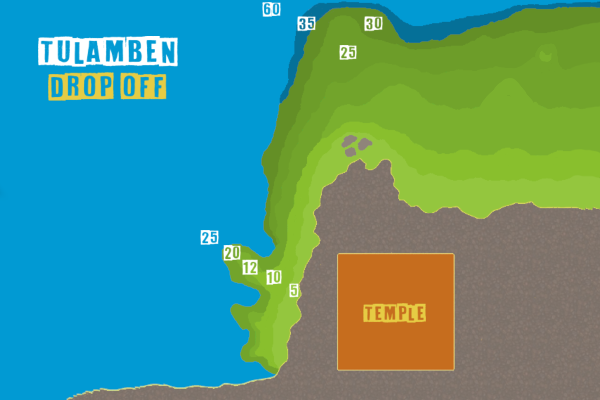
Located on the eastern end of Tulamben Bay, Drop Off — also known as Tulamben Wall — is one of the most dramatic dive sites in the area. Formed from old lava flow from the 1963 eruption of Mount Agung, this site features a steep underwater cliff that drops from just a few meters deep to more than 70 meters, although most recreational dives are conducted between 5 and 30 meters.
Access is from shore, with a short walk across the pebble beach and an easy surface swim before reaching the wall. The site starts with a sloping reef that quickly gives way to a vertical drop, covered in sponges, sea fans, and vibrant coral growth. The wall structure provides shelter and feeding ground for a wide variety of reef life, and visibility is often excellent.
You’ll encounter schools of fusiliers, damselfish, angelfish, and sometimes turtles cruising by. In the deeper parts of the wall, you might spot groupers, reef sharks, and occasionally even a napoleon wrasse. For macro lovers, Drop Off is also a good place to search for leaf scorpionfish, nudibranchs, whip coral shrimp, and ornate ghost pipefish. There is also a chance to spot pygmy seahorse denise or Bargibanti.
This site is versatile and rewarding — it’s suitable for beginners when staying shallow and guided, but also offers exciting exploration for experienced divers, including deep dives, wall dives, and great opportunities for underwater photography.
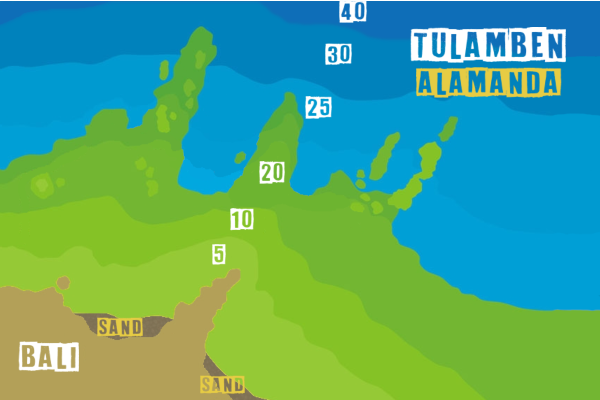
Located just after the popular Drop Off site on the eastern side of Tulamben Bay, Alamanda is one of the area’s most underrated dive sites, offering both healthy reef systems and a more tranquil dive experience. It is accessible only by traditional jukung boat, which allows flexible entry and exit points — ideal when there’s light current and to ensure the best part of the reef is explored. This site is less frequented, which makes it a great choice for divers looking for healthy reef systems, light current drift, and excellent biodiversity without the crowds.
The dive begins on a gentle slope that gradually turns into patches of coral bommies, rocky outcrops, and soft coral areas — a topography that offers a refreshing variety compared to other nearby sites. Schools of fusiliers, anthias, and snapper are common, while barracuda and trevally may make passing appearances. Macro lovers can search among the coral heads and rubble zones for leaf scorpionfish, pipefish, mantis shrimp, and even octopus.
Because it is reached by boat, Alamanda offers flexible entry and exit points, which is especially helpful in managing current and optimizing the dive route. It’s a great option for intermediate to advanced divers looking for something different — with fewer divers and plenty to discover.
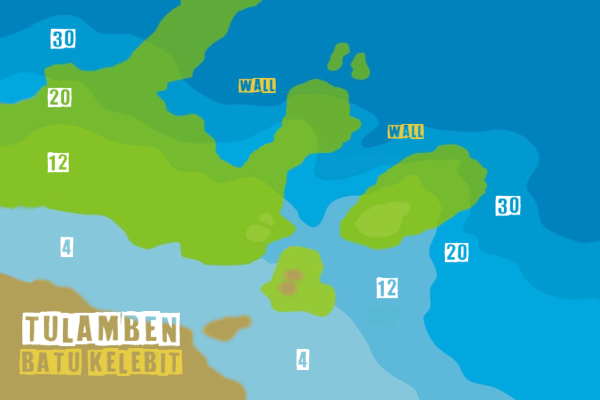
Batu Kelebit is one of the most scenic and less-visited dive sites in the Tulamben area, located just a short jukung ride beyond Alamanda. Accessible only by traditional boat (jukung), this site is best suited for intermediate and advanced divers due to its depth, open water conditions, and potential for light currents.
The site features two large submerged pinnacles that rise from the sandy bottom at around 40 meters to the shallower reef around 18–20 meters. These rocky structures are covered in vibrant hard and soft corals, with plenty of sea fans, sponges, and encrusting life, creating a visually dramatic underwater scene.
Batu Kelebit is a great place to see larger reef fish, including groupers, snappers, trevally, batfish, and sometimes even white-tip reef sharks or passing pelagics in deeper water. The clear visibility, depth, and bold features make this a favorite for deep divers, wide-angle photographers, and those looking for a more adventurous reef profile. While macro isn’t the primary focus here, you might still spot nudibranchs or small shrimps tucked into crevices.
The site’s pinnacle topography, combined with open water exposure, makes it important to dive with experienced guides who know how to manage drift and depth safely. It’s an excellent second dive for those already exploring Tulamben’s deeper terrain.
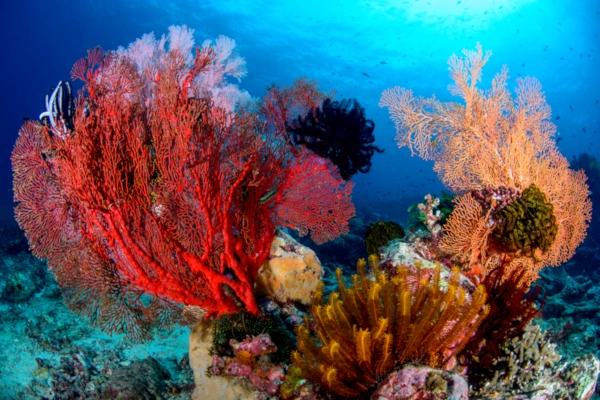
Emerald is a wide, open dive site located in front of the abandoned hotel just beyond Batu Kelebit, accessible only by traditional jukung boat. The dive begins in a shallow bay with a sandy white bottom, which gives the water a beautiful, bright ambiance — especially in the morning light. Although the inner bay has fewer coral structures than it once did, it still offers a peaceful start to the dive and serves as a great warm-up area.
Scattered along the sandy slope, you’ll find old artificial reef structures and coral patches, often home to ribbon eels, moray eels, shrimps, and small reef fish. As the dive progresses, the topography deepens gently into a slope covered in soft corals, sea fans, and occasional sponges, leading toward more active reef zones.
While Emerald has lost some of its former glory, it remains an enjoyable site thanks to the natural lighting, easy descent, and the potential to connect with neighboring dive sites. On many dives, you’ll start in Emerald and drift toward Batu Kelebit’s shallower reef, or on rare occasions, continue even further to Alamanda, depending on current direction and strength.
The deeper sections of Emerald may still surprise you with sightings of snapper schools, batfish, leaf scorpionfish, and the occasional pelagic cruising through. It’s a quiet site, ideal for divers who enjoy exploration and mood-setting underwater landscapes.
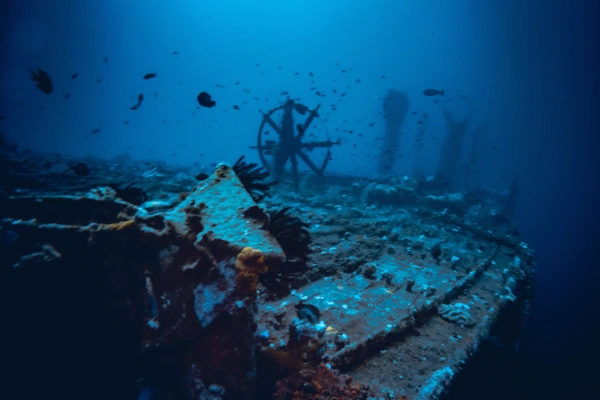
Located just a few minutes’ drive west of Tulamben, the Kubu Wreck, also known as the Boga Wreck, is one of the best deep wreck dives in the area. This 40-meter-long artificial wreck was intentionally sunk in 2012 to serve as an artificial reef and dive attraction. It now rests at a depth of 18 to 38 meters, perpendicular to the shoreline, and is best suited for Advanced Open Water divers or those with equivalent experience due to its depth.
Access is via shore entry from Kubu village, near the temple parking area. After entering the water, divers follow a 6-minute swim heading northwest to reach the wreck. Descending along the slope, you’ll arrive at the ship’s top section and begin your exploration.
The wreck is equipped with open corridors, a large bow section, and its most famous feature — a fake steering wheel, still a favorite for underwater photos. Although the original wooden deck has been eaten away by sea worms, you can still spot the nails and metal outlines that remain. Inside the wreck, divers will discover a mix of artificial decorations, including amphorae, old scuba tanks, statues, and even an old jeep, adding a sense of mystery and fun to the dive.
Marine life around the structure includes barracuda, snappers, lionfish, groupers, and various nudibranchs, shrimps, and sometimes ghost pipefish near the sandy base. The site is also great for Nitrox dives, wreck specialties, and deep training dives.
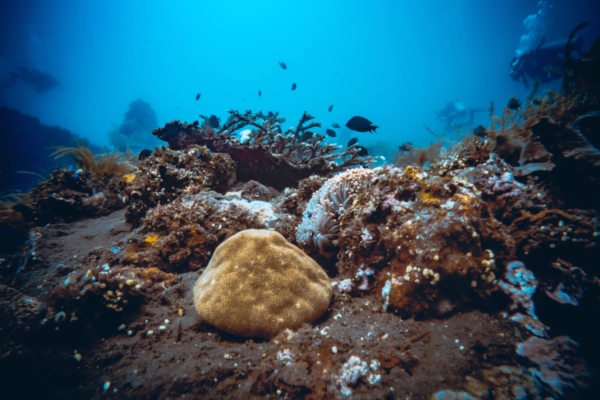
Located next to the Boga Wreck, Kubu Reef is a quiet and colorful shore dive that offers a pleasant mix of natural coral life and playful underwater surprises. Entry is made from the same beach near the temple parking area in Kubu village, but instead of heading toward the wreck, divers explore the southern side of the site.
The dive begins with a rocky entry over large pebbles and rounded stones, leading to a shallow plateau around 3 to 6 meters deep. This first section is covered in small rocks encrusted with sponges and algae, offering shelter for shrimp and tiny reef fish. From there, the reef slopes down into black sand, broken up by scattered coral patches and bommies where fish and macro life gather.
One of the unique highlights of Kubu Reef appears at the end of the dive, if you head slightly east: a small zone where bicycles, motorbikes, and other artificial objects have been placed over the years. These items are now partially covered in corals and algae, attracting marine life and offering a fun photo opportunity for divers.
The site is well-suited for all levels of certified divers, with mild conditions, interesting macro life, and the option to do it as a relaxed second dive after the Boga Wreck.

Batu Ringgit is a quiet and underrated shore dive site located just north of the Kubu Wreck, and directly before reaching Gerombong. It’s a favorite among experienced divers and photographers looking for a true macro treasure hunt, far from the more frequented sites of Tulamben Bay.
The dive starts with a rocky beach entry over rounded pebbles, leading to a shallow area around 3–5 meters deep, and then gently sloping down to about 25 meters. The underwater topography alternates between black sand, rubble patches, and coral-covered ridges, with occasional rocky outcrops and terraces that create perfect hiding places for critters.
Batu Ringgit is all about macro diving — especially for those who enjoy taking it slow and searching for the rare and the strange. Depending on the season, you may encounter ghost pipefish, frogfish, whip coral shrimp, leaf scorpionfish, and the elusive donut Doto nudibranch. As with many macro dive sites in Tulamben, critter density changes throughout the year — which is why our experienced guides & spotters choose sites daily based on current sightings and updates from the local dive community.
Thanks to its low diver traffic and naturally sheltered setting, Batu Ringgit is ideal for dedicated macro dives, underwater photography, or a relaxed second dive with good lighting and visibility.

Gerombong is the northernmost dive site of the Tulamben coastline and a true hidden gem for macro diving enthusiasts. Rarely visited by large groups, it offers a peaceful underwater setting with a mix of black sand, rocky ridges, and rubble patches, making it ideal for critter hunting and macro photography.
Accessed via a shore entry, the dive begins with a shallow pebble zone, quickly leading into a sloping black sand bottom that extends down to about 25 meters. Along the slope, you’ll find isolated coral heads, sponges, and small overhangs, which become natural shelters for all kinds of small marine life.
The surface facilities at Gerombong are among the most diver-friendly in the area, with dedicated parking, rinse tanks, changing rooms, and toilets — making it a convenient base for underwater photographers and macro-focused dive days. It’s also one of the favorite sites for macro photography competitions, thanks to its critter density and quiet setting.
Gerombong is known for its seasonal macro surprises, including ghost pipefish, various species of nudibranchs, juvenile lionfish and frogfish, shrimps, and the occasional different kind of octopuses. Like other specialized macro sites in the area, conditions can change throughout the year, and our dive guides select this site when it’s “hot” based on up-to-date sightings and shared reports from the local dive network.
With minimal diver traffic and a peaceful setting, Gerombong is best enjoyed by those who like to move slowly, observe details, and take the time to search for the hidden gems of Bali’s underwater world.
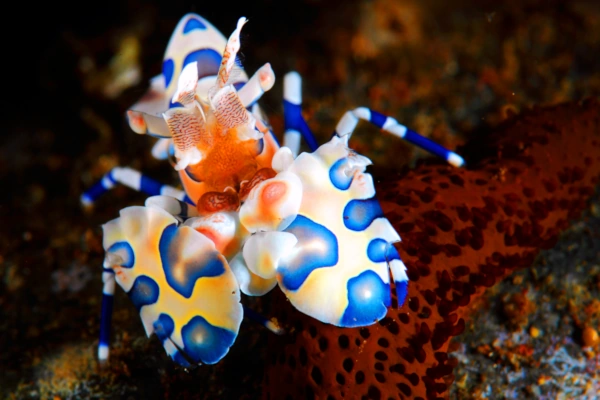
Seraya Secret is one of the most famous macro dive sites in Bali, and a must-visit for macro enthusiasts and underwater photographers. Located just a short drive south of central Tulamben, this shore-access site has built a global reputation for its black sand slope, rare critters, and incredible macro biodiversity — especially during the right season.
The dive starts from a pebbled beach with a shallow entry, followed by a gentle slope of fine black sand that extends to about 40 meters. You won’t find big coral formations here — the charm of Seraya lies in the small details, as the dark sand provides a perfect background for spotting highly camouflaged species. Since recent years more structures have been added to the dive site, corals are in progress on them.
Divers often encounter harlequin shrimp, frogfish, ghost pipefish, zebra crabs, squat lobster, and many types of nudibranchs and juvenile fish. The site is also home to decorator crabs, some cleaning station with big moray eel, and during the right season, the rare pygmy seahorse bargibanti.
Seraya Secret is best explored slowly, moving inch by inch with a sharp eye and the guidance of a knowledgeable dive guide. Many divers visit Seraya multiple times during their trip, as sightings can vary from day to day. Our guides regularly exchange updates with the local dive community, ensuring you’re taken to the right zone with the best chance of rare finds.
Surface facilities at Seraya include rinse tanks for camera, showers, toilets, and small gazebos, making it a convenient spot to spend a 2 dives day focused on macro. It’s also been used as a base for underwater macro photography workshops and critter-focused dive trips.

Melasti is one of Tulamben’s most renowned macro dive sites, located just north of Seraya Secret. Known for its black sand slopes, patchy rubble zones, and incredible biodiversity, Melasti is a favorite among underwater photographers and muck diving enthusiasts.
This is a shore entry site starting from a pebble beach, leading to a gentle sand slope that reaches over 30 meters deep. What makes Melasti especially interesting is the contrast between its left and right sides, each offering unique habitats and critter sightings.
Heading left from the entry point brings you to open black sand mixed with patches of halimeda algae and sea grass. This side is excellent for finding small nudibranchs like Costasiella or Stiliger spp., often grazing on the algae.
Heading right, the slope becomes more textured with pebbles, scattered rubble, and a few sponge-covered zones. Here, you’re more likely to encounter warty frogfish, seahorses, ghost pipefish, and a wide variety of nudibranchs and crustaceans hiding among the rock, feather stars and sponge formations.
Melasti is a site that rewards slow, observant diving. It’s not unusual to spend an entire dive exploring just a small section of the slope. As with other macro-focused dive sites in Tulamben, marine life density varies with the seasons, and our experienced dive guides choose the most productive zone based on up-to-date local sightings.
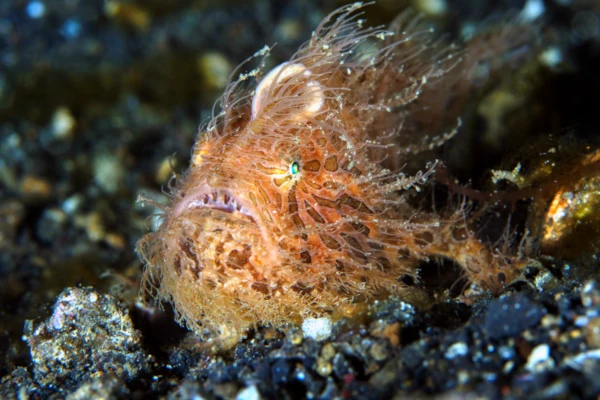
Batu Niti is a quiet, macro-focused dive site just south of Seraya Secret, nestled between two of Tulamben’s most productive muck diving zones — Seraya and Sidem. It’s a hidden gem known for occasional big critter encounters, a peaceful setting, and surprising macro diversity when the conditions are right.
The site is accessed by shore entry from a small parking area that offers gazebos and basic dive setup facilities. While you can start the dive directly in front of the parking, we recommend beginning about 150 meters to the right, or even better at the end of the beach near a spot where lava rock formations descend into the sea. This protected area features some small coral reef patches, sponges, and rocky ledges — a great place to search for giant frogfish, ghost pipefish, or octopuses.
From there, the dive transitions into a gently sloping black sand and rubble area, where careful observation can reveal a wide range of macro critters, including hunting predators like warty frogfishes, Rhynopias, scorpionfish. Good variety of nudibranchs depending on the season and near cleaning stations, lots of shrimps and juveniles fishes.
Because Batu Niti lies between Seraya and Sidem, its location often makes it a sweet spot for seasonal macro species, and our Bali Aqua guides monitor daily sightings to plan dives here when the timing is right. It’s an excellent site for slow-paced exploration, macro photography, or a second dive following Seraya Secret.
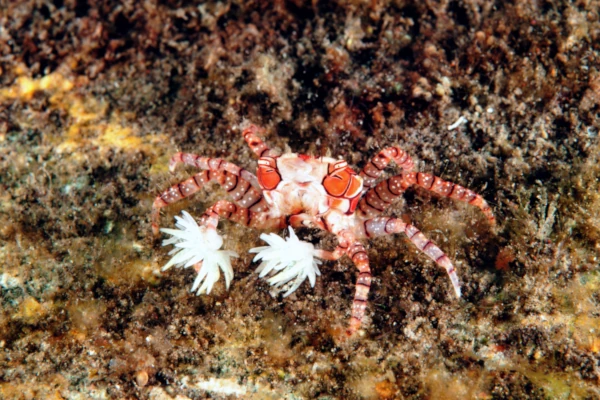
Tai Sapi is a lesser-known muck dive site tucked between Seraya Secret and Batu Niti, positioned just to the left of the river outlet. Accessible only during the dry season, when the river is dry and visibility is stable, Tai Sapi offers a quiet, critter-rich experience for divers looking to escape the more frequented macro zones.
From the shore entry, the dive begins with a narrow beach and shallow plateau, leading into a gently sloping black sand bottom. The site is naturally divided by the riverbank into two distinct dive zones:
Heading left (toward Seraya) offers a sandy bottom interspersed with coral patches and healthy macro fauna. This side is excellent for spotting frogfish, ghost pipefish and rare nudibranchs, all without diver crowds — making it perfect for macro photographers.
Heading right (toward Batu Niti) leads into a fine, almost silty sand zone, with a more challenging terrain. When conditions are good, this side can reveal pompom crabs, pipefish, and sand-dwelling shrimp, but it’s also more sensitive to stirred-up sediment, which can reduce visibility quickly — a true “real muck dive”.
Because it’s rarely dived and highly seasonal, Tai Sapi is one of those sites where guide knowledge is essential. At Bali Aqua, our dive team checks local conditions and shares updates with the diving community to choose the best zone on the best day.
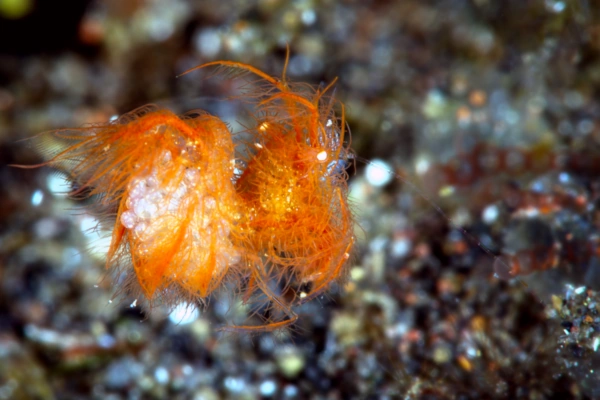
Sidem is a well-loved macro dive site located south of Batu Niti, just near Batu Belah temple. Once a quiet spot, it has grown in popularity among underwater photographers and critter hunters thanks to its reliable black sand slope, peaceful entry, and diver-friendly facilities right on the beach.
The entry point is from a neatly organized pebble beach, where traditional jukung fishing boats rest after returning from early morning trips. The dive starts on a shallow plateau about 20 meters wide, which gradually gives way to a sloping black sand bottom that extends deeper than recreational limits — though most dives stay within the 5–30 meter range.
Macro life here is dense and diverse, especially during the right season. Divers often encounter warty or painted frogfish, different kind of ghost pipefish, thorny seahorse, nudibranchs, boxer shrimp, and occasionally hairy & tiger shrimp, rhynopias. Thanks to the slope’s structure and scattered rubble, many critters hide in plain sight — if you know where (and how) to look.
An occasional surprise is the presence of green sea turtles feeding on fast-growing green seagrass on the plateau, especially in certain seasons — a welcome sight after a dive focused on tiny critters.
The setup at Sidem is one of the most comfortable in the area: gazebos, rinse tanks (including for cameras), shaded tables, and even a small shop offering tea, coffee, and snacks make it easy to spend the whole morning or afternoon here. Because of its popularity, our Bali Aqua dive guides monitor activity and critter sightings daily, selecting the best times to dive here to avoid crowds and maximize macro success.
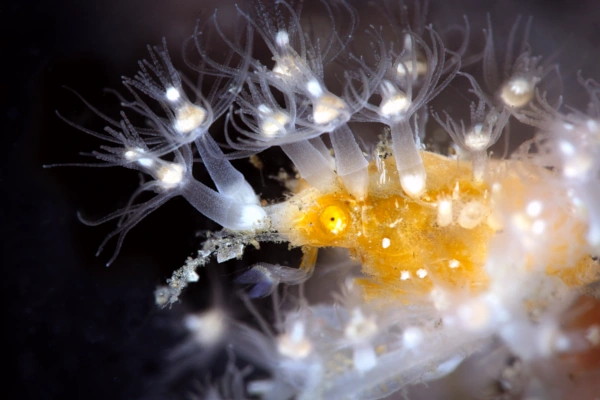
Segara is a calm and underrated shore dive site located just south of Tulamben’s main village area, near Segara Temple just after Emerald but on the far north west coast of the next bay. Segara dive site offers a gentle sandy slope, easy shore access, and a rewarding combination of reef life and macro critters — perfect for beginner divers and seasoned photographers.
Entry is easy here thanks to the fine black sand and minimal rocks. The dive begins on a shallow coral plateau at around 3 meters, gradually transitioning into a sandy slope with few rubble down to 30+ meters.
While Segara is often chosen for training dives and easy exploration, it’s also a hidden macro haven. Look closely and you may find some Shaun the Sheep nudibranchs on the halimeda grass, other nudibranchs, shrimp, frogfish, or tiny decorator crabs. These sit quietly among rubble patches or cling to small sponges and seaweed.
If you head left toward Emerald, you’ll encounter bigger coral structures, stingrays feeding in the sand, school of mackerels cruising the reef edge. This makes Segara appealing not just to macro photographers, but also to divers who enjoy mixed terrain and relaxed reef dives.
Thanks to its versatility, Segara is a great site for long, low-stress dives, offering something for every diver — from new students to seasoned underwater shooters.
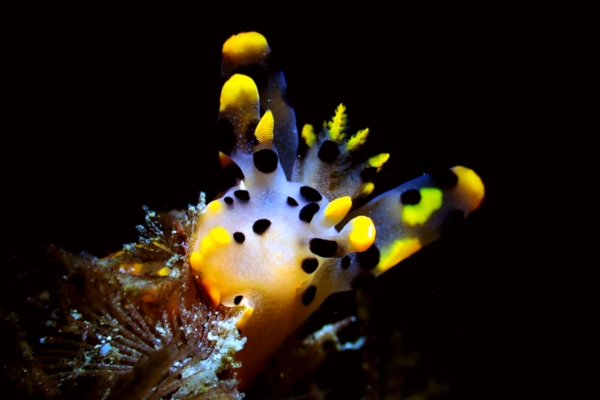
Cantik Point — meaning “beautiful point” in Indonesian — is a quiet macro dive site nestled between Segara and just north of Tulamben’s more famous macro dive site Melasti. This Tulamben dive site offers peaceful conditions, low diver traffic, and high potential for rare critters, especially when the macro season is at its peak.
The dive starts with a gentle shore entry from a small beach, leading into a sloping black sand bottom that reaches 30+ meters. The topography is simple and ideal for muck diving: fine sand, sparse rubble, scattered coral patches, and occasional sponges or sea grass tufts.
Cantik Point is perfect for macro photographers looking for a quiet and rewarding dive. The site regularly offers encounters with nudibranchs, pipefish, mantis shrimp, dragonets, frogfish, and juvenile lionfish. The soft sand and scattered structures provide ideal hiding spots for many of Bali’s most fascinating small marine life.
Because it’s located just before Melasti, Cantik Point benefits from the same macro biodiversity trend, but with even fewer divers around. Our Bali Aqua dive guides monitor critter activity across the Tulamben coastline and recommend Cantik Point when it’s showing signs of life — making it a strategic choice for serious macro seekers.
At Bali Aqua Dive Center, we offer daily trips and package options to explore the best dive sites in Tulamben — all fully organized from Sanur and South Bali. Whether you want to visit the legendary USAT Liberty Wreck, explore macro-rich sites like Seraya and Melasti, or combine it all in a multi-day plan, we make it easy and comfortable.
Our Tulamben day trips include round-trip transport in air-conditioned vehicles, experienced dive guides, full gear rental, and 2 to 3 guided dives depending on your choice. Thanks to our early departure, we reach Tulamben with plenty of time to dive.
If you prefer a more immersive experience, our dive & stay packages allow you to spend 2 to 4 days in Tulamben, staying in hand-picked hotels right near the dive sites. This way, you can enjoy early morning or night dives, explore more dive sites at a relaxed pace, and make the most of what Tulamben has to offer.
Want to go even further? Our Best of Bali (BOB) and full board Dive Bali Safari programs include Tulamben as a highlight, along with other world-class destinations like Nusa Penida, Padang Bai, and Menjangan.
Planning a dive trip to Tulamben? Here are some essential tips to help you get the most out of this iconic Bali diving destination — whether you’re here for the Liberty Wreck, a macro hunt, or relaxed reef dives.
Tulamben offers year-round diving, but the best visibility and calmer surface conditions are usually from April to November during Bali’s dry season. Macro lovers often prefer the wet season months (October to March), when certain critters are more active and unique species appear.
Tulamben is ideal for:
Tulamben is not only home to Bali’s most famous wreck — it’s also a world-renowned destination for macro diving. Divers from around the globe come here to explore the black sand slopes, rubble patches, and hidden critter havens that make Tulamben a dream location for underwater photography and critter hunting.
The volcanic black sand along Tulamben’s coast creates the perfect backdrop for spotting highly camouflaged marine life. Many dive sites — like Seraya Secret, Melasti, Sidem, and Batu Niti — are known for their incredible diversity of small species, often hiding in plain sight.
With minimal coral and fewer distractions, your eyes are drawn to the tiny details:
Tulamben is one of the top macro photography destinations in Southeast Asia. Thanks to calm conditions, long bottom times, and gentle slopes, it’s easy to stay still and wait for the perfect shot.
You’ll find:
Our team at Bali Aqua Dive Center works closely with guests to choose the best sites and dive conditions for photography — including seasonal critter patterns, time of day, and site rotation.
One of the most exciting things about macro diving in Tulamben is that no two dives are ever the same. Many critters are seasonal or nomadic, meaning their presence shifts depending on temperature, currents, or breeding cycles.
That’s why we rely on our experienced local guides, who stay up to date with daily critter reports and local guide network updates, helping you dive the right site at the right time.
With over 15 years of experience diving Tulamben, Bali Aqua Dive Center has developed deep local knowledge of each dive site — from the world-famous Liberty Wreck to the most seasonal macro hotspots only known to experienced guides. Whether you’re a beginner diver or a dedicated underwater photographer, we tailor your dive day for comfort, quality, and results.
Our team is made up of passionate local and international guides who live and breathe Tulamben. Many of our staff have guided thousands of dives across this coastline and have a sharp eye for macro life — from spotting a pygmy seahorse the size of a grain of rice to helping you position for the perfect nudibranch shot.
Because macro sites are constantly changing with critter migrations, weather, and currents, we don’t follow a fixed schedule. Instead, we plan your dives based on:
Since Bali Aqua also runs full-board Dive Safaris and dive packages covering all regions of Bali, our guides are constantly rotating through Tulamben, Amed, Nusa Penida, Padang Bai, and Menjangan. This means we have the most up-to-date information on site conditions, critter activity, and logistics — giving you the advantage of expert-level dive planning every day.
Whether you want to see the iconic USAT Liberty Wreck, searching for rare macro critters, or just want to experience Bali’s most diverse diving coastline, Tulamben has something unforgettable waiting underwater — and Bali Aqua Dive Center is here to guide you every step of the way.
With our experienced dive team, customizable dive packages, and up-to-date knowledge of each site’s conditions, we ensure every dive is tailored to your interests and comfort level.
👉 Join us for a daily dive trip, a multi-day package, or include Tulamben in your Best of Bali Dive Safari — and experience why divers from all over the world keep coming back.
📩 Contact us now to plan your perfect dive day in Tulamben or explore our full selection of dive programs around Bali.